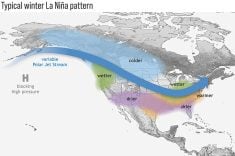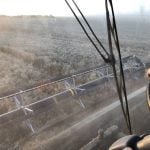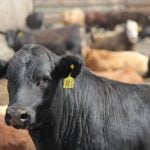KANANASKIS, Alta. (Staff) – With government cuts and changing interests among children, 4-H continues to look for innovative ways to keep up with the times.
During their annual meeting at Kananaskis, Canadian 4-H Council members shared their program ideas and commiserated over fund-raising efforts and other challenges they face each year. A session talking about each member province’s highlights revealed how the youth program is consistent across the country with the added flavor of regional differences.
Some of the highlights are as follows:
Prince Edward Island
Read Also

Trump’s tariffs take their toll on U.S. producers
U.S. farmers say Trump’s tariffs have been devastating for growers in that country.
Members raised $11,647 in the fall of 1994 by selling cheese, said Louise Andrews. A wildlife project with leader manuals and program ideas was created. An exchange with youths from Kenya was held last year.
Nova Scotia
Nova Scotia’s council along with the department of agriculture’s extension services have taken 4-H to the Czech and Slovak Republics, said Liz Crouse. The Czechs have opened 4-H clubs in about 30 villages while the Slovak Republic is just getting started.
Quebec
Quebec Young Farmers is this province’s farm youth program which is comparable to 4-H, said Sylvie Mahannah. Unlike many 4-H programs, government is not involved. There are 10 clubs with 350 members across the province. Besides participation in local meetings and fairs, the young farmers gather at four annual provincial events – a livestock management tour, square dance competition, education day and a calf rally.
Ontario
This province marks 80 years of 4-H and one of the biggest projects for the council will be a plan to map out the organization’s future, said Allan Payne. The council wants youths to tell them where they want 4-H to go and suggest ways to keep the clubs viable as cities expand and rural areas shrink.
Manitoba
Last year was International Year of the Family which Manitoba marked by giving special recognition to longtime 4-H members. In total, 56 fourth-generation and 482 third-generation 4-H families were honored, said Karen Dowsett. The minimum age to join 4-H was dropped from nine to eight since the organization competes with several other youth groups who take children at five.
It was also the 10th anniversary for the province’s Japanese exchange, which included some Manitobans going to Japan as well.
Clubs earned $32,000 from the provincial highway department for its annual highway cleanup campaign.
Saskatchewan
A professional fundraiser has been hired by the provincial council. Government cuts to agencies left the provincial council uncertain about future public support, said Mary Lou Dice. To save money, Dice suggested councils start sharing more of their materials for similar projects to save on printing costs and program development.
Alberta
For the first time this province has introduced a $25 membership fee to cover financial shortfalls following last year’s 30 percent government cut. Membership declined from 8,151 in 1993-94 to 7,681 in 1994-95. Mahlon Weir of Alberta Agriculture said the drop could be due to reasons other than the fee. Users fees were also attached to some programs and camp fees went up.
Another new idea, called the key leader program, has provided supplemental training to 59 volunteers in 57 districts. These leaders work with clubs and districts providing leader support, information and partnership building between councils and clubs.
British Columbia
After facing criticism in newspapers over livestock projects, the provincial agriculture department and the 4-H council have put together a program to handle questions and challenges called Animal Welfare and Animal Rights Education (AWARE). So far, 30 4-H leaders have received training in this program, said Gordon Bryant of the department.














